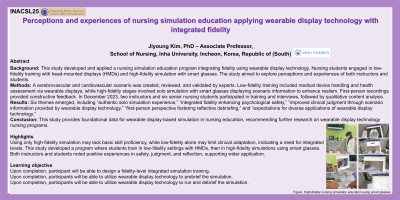Education
(61) Perceptions and experiences of nursing simulation education applying wearable display technology with integrated fidelity
Thursday, June 19, 2025
5:00 PM - 6:30 PM MST
Location: Exhibit Hall


Jiyoung Kim, PhD
Associate Professor
Inha University
Incheon, Inch'on-jikhalsi, Republic of Korea
Lead Author(s)
Abstract:
Background: This study developed and applied a nursing simulation education program integrating fidelity using wearable display technology. Nursing students engaged in low-fidelity training with head-mounted displays (HMDs) and high-fidelity simulation with smart glasses. The study aimed to explore perceptions and experiences of both instructors and students.
Methods: A cerebrovascular and cardiovascular scenario was created, reviewed, and validated by experts. Low-fidelity training included medical device handling and health assessment via wearable displays, while high-fidelity stages involved solo simulation with smart glasses displaying scenario information to enhance realism. First-person recordings provided constructive feedback. In December 2023, two instructors and six senior nursing students participated in training and interviews, followed by qualitative content analysis.
Results: Six themes emerged, including “authentic solo simulation experience,” “integrated fidelity enhancing psychological safety,” “improved clinical judgment through scenario information provided by wearable display technology,” “first-person perspective fostering reflective debriefing,” and “expectations for diverse applications of wearable display technology.”
Conclusion: This study provides foundational data for wearable display-based simulation in nursing education, recommending further research on wearable display technology nursing programs.
Please include a short summary of your presentation that highlights why an attendee would want to view your poster.: Using only high-fidelity simulation may lack basic skill proficiency, while low-fidelity alone may limit clinical adaptation, indicating a need for integrated levels. This study developed a program where students train in low-fidelity settings with HMDs, then in high-fidelity simulations using smart glasses. Both instructors and students noted positive experiences in safety, judgment, and reflection, supporting wider application.
Background: This study developed and applied a nursing simulation education program integrating fidelity using wearable display technology. Nursing students engaged in low-fidelity training with head-mounted displays (HMDs) and high-fidelity simulation with smart glasses. The study aimed to explore perceptions and experiences of both instructors and students.
Methods: A cerebrovascular and cardiovascular scenario was created, reviewed, and validated by experts. Low-fidelity training included medical device handling and health assessment via wearable displays, while high-fidelity stages involved solo simulation with smart glasses displaying scenario information to enhance realism. First-person recordings provided constructive feedback. In December 2023, two instructors and six senior nursing students participated in training and interviews, followed by qualitative content analysis.
Results: Six themes emerged, including “authentic solo simulation experience,” “integrated fidelity enhancing psychological safety,” “improved clinical judgment through scenario information provided by wearable display technology,” “first-person perspective fostering reflective debriefing,” and “expectations for diverse applications of wearable display technology.”
Conclusion: This study provides foundational data for wearable display-based simulation in nursing education, recommending further research on wearable display technology nursing programs.
Please include a short summary of your presentation that highlights why an attendee would want to view your poster.: Using only high-fidelity simulation may lack basic skill proficiency, while low-fidelity alone may limit clinical adaptation, indicating a need for integrated levels. This study developed a program where students train in low-fidelity settings with HMDs, then in high-fidelity simulations using smart glasses. Both instructors and students noted positive experiences in safety, judgment, and reflection, supporting wider application.
Learning Objectives:
- Upon completion, participant will be able to design a fidelity-level integrated simulation training.
- Upon completion, participants will be able to utilize wearable display technology to prebrief the simulation.
- Upon completion, participants will be able to utilize wearable display technology to run and debrief the simulation.
